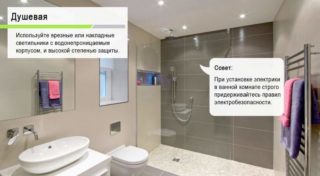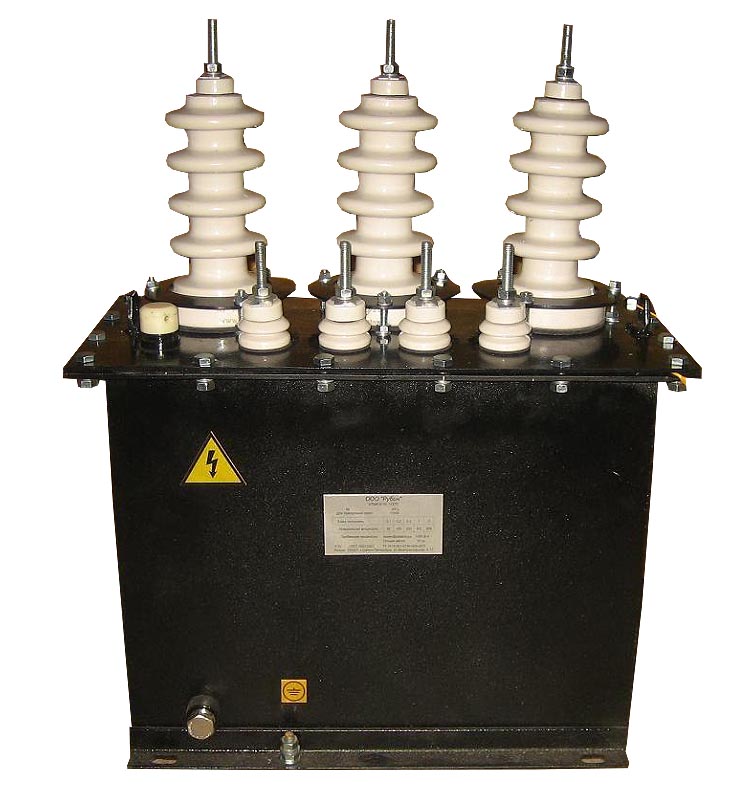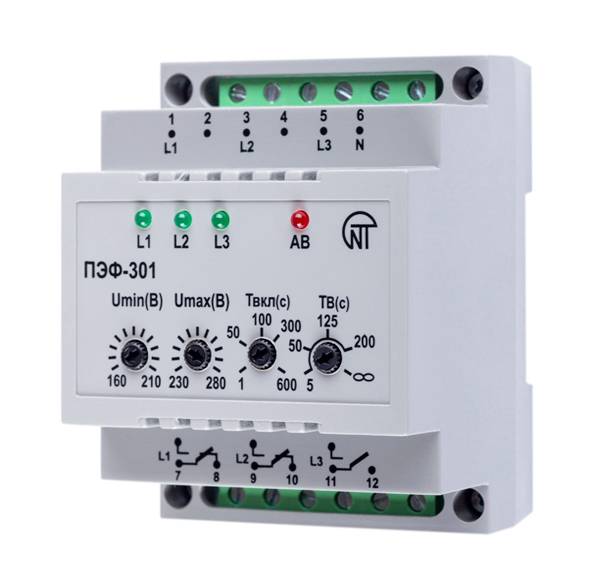Lighting in the bathroom performs the main function - providing the room with the necessary light - and also plays the role of decorative design. An integrated approach to this issue requires careful design of the room and the choice of lamps.
- Number of fixtures
- Lighting design techniques
- Ceiling light organization
- Emphasis on the main interior element
- Mirror lighting
- Highlighting furniture
- Lower level
- Individuality and self-expression through lighting
- Characteristics of various lamps
- Security index and bathroom zones
- Moisture zones
- Fixing methods for fixtures
- Installation of electrical wiring in the bathroom
- How to properly mount lamps
- Safety regulations
Number of fixtures
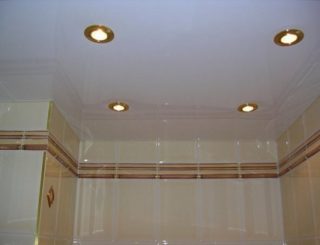
The number of bulbs and their power in the bathroom directly depends on the area of the room.
- Up to 5 square meters - from 60 to 150 W.
- 5 to 10 square meters - the power ranges between 80 and 250 watts.
- 10 to 15 square meters - lighting at the level of 100-400 W.
- 15 to 20 square meters - the minimum degree is 200 W, the maximum is 500 W.
- 20 to 30 square meters - the brightness of the light is set on the verge of 240-700 W.
The minimum value corresponds to soft light, and the maximum value is very bright. However, general lighting is not enough, you need to take care of the functional. We are talking about the areas around the mirror, washbasin and bathroom.
It is also recommended to consider an option with a decorative light source in the form of a garland or atmospheric lamp.
Lighting design techniques
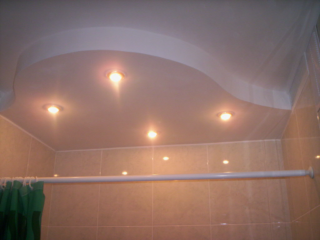
Interior designers, with the help of several types of light sources and diverse placement, can radically change the style of a room:
- visually enlarge or reduce the room;
- create the necessary environment (romantic or purely practical).
To achieve the expected lighting effect in the bathroom, a number of simple guidelines should be followed.
Ceiling light organization
Any bathroom involves an overhead light. This role can be performed by:
- decorative designer chandelier (for artsy interior);
- Spotlights.
In the first case, it is enough to place the lamp in the center of the ceiling; in the second, you need to work on the placement. You can place light bulbs in the central part or above functional areas.
It is necessary to ensure that there are no shaded areas in the room.
For greater brightness of light, use reflective surfaces or devices. For example, an aluminum pendant with small lights that direct the light downward. This arrangement creates a fabulous atmosphere.
Emphasis on the main interior element
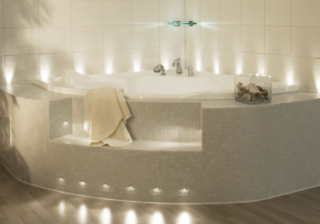
The light in the bathroom focuses on the main plumbing - the bathroom. It stands out in the following ways:
- Installation of equipment on a hill. The pedestal itself below is striking with point lighting along the entire perimeter.
- The bathing bowl is equipped with a minimalist ceiling chandelier or an ordinary shade.
- LED lighting in the bathroom. Located at the edge of the tub, the lines of light create the illusion of flowing water.
A rather attractive option is being considered with an autonomous light hidden in the bath itself.
If there is a shower room in the room, you should place accents on the watering can. For greater effect, the light bulb is mounted directly into the watering device, after which the water jet takes on a new color.
Mirror lighting
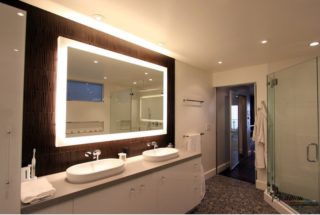
Even in a small Khrushchev, there is a mirror in the restroom, which is the basis of the working area. It is installed in most cases over a washbasin or next to a vanity unit with cosmetics. Before choosing mirror bulbs, it is important to familiarize yourself with three rules:
- give up blinding light;
- minimize the formation of shadows on the face;
- ensure that the color temperature of the light sources matches the natural color as much as possible.
Natural light equals light on a sunny, cloudless day.
There are two options: stand-alone or recessed lighting. In the first case, two lamps are attached on the sides and on top. In the second, the mirror is equipped with hidden illumination.
Highlighting furniture
The bathroom usually contains detergents and hygiene products. In order not to leave objects in sight, they are placed in small wall or floor tables.
The fittings do not require a bright highlight with light. However, for ease of use, you can equip them with functional lighting, with which you can distinguish all things and get what you need.
Lower level
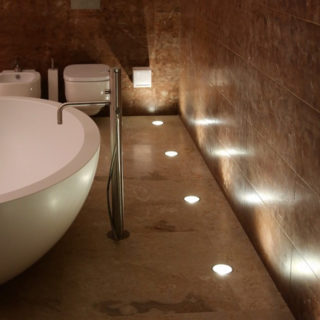
The light underlining of the room parameter performs two functions: decorative and emergency. To beautifully highlight the floor area or low levels of furniture, sealed low-power bulbs are used - the performance does not exceed five watts, and the diameter is five centimeters.
A more original approach to lighting will be provided by an LED strip that is resistant to moisture. If this method is used to enclose the entire perimeter of the bathroom, there is a feeling of floating and weightlessness.
Individuality and self-expression through lighting
With the help of well-chosen light in harmony with the interior, you can embody the underwater world or the night sky within the same room. You can also follow all the rules of the loft, leaving the twisted light bulbs on the same wires in order to dim the bright light at any time.
For the correct lighting, different types of lamps are selected that differ in brightness and are responsible for certain zones.
Characteristics of various lamps

When decorating a room with a toilet, you need to choose the type of light bulbs. The most popular are:
- Incandescent lamps. An artificial light source is capable of emitting light rays due to the heating of the incandescent body by an electric current. Differs in comparative cheapness and resistance to voltage drops. However, significant disadvantages can be traced: short operational life, fragility and high fire hazard. Better to apply them near the makeup table.
- Halogen lamps. The principle of operation is the same as that of Ilyich's bulbs, only there is a distinctive feature - there is a buffer gas. The good thing is that in some cases there is a mode for adjusting the angle of illumination, high resistance to moisture. Suitable for baths with classic interior design.
- Fluorescent lamps. In mercury vapor, ultraviolet radiation is generated through an electrical discharge, which is converted into visible light with the help of phosphors. Best used to illuminate large areas.
- LEDs. The luminaires are equipped with semiconductor devices that emit white or another color. Unlike other models, the described lamps are distinguished by a high level of fire safety and provide maximum natural effect.
The use of any type of light bulb is limited to functional areas and safety rules. All standards are built on the basis of the security index.
Security index and bathroom zones
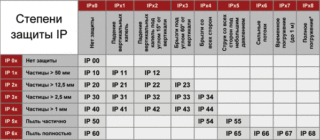
- The first digit is responsible for protection from dust and dirt. Estimated within the range of 0-6 points.
- The second determines moisture resistance. The score is set within 0-8 points.
- The third shows impact resistance.The ability to resist mechanical stress is rated 0-10 points.
The higher the coefficient, the higher the quality of the product. Understanding the designations helps the buyer to correctly navigate the assortment and choose the right product.
Moisture zones
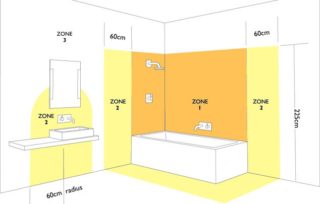
There are several moisture zones:
- Highest degree. There is a bath bowl (space above and below it) or a shower stall, water flows, steam and condensation are formed. Light bulbs must have a power of no more than 12 W and with a maximum protection index.
- Increased level. Water enters the luminaires in the form of droplets or steam. Applies to washbasin and adjacent surfaces. The security factor must be at least 450 IP.
- Moderate humidity. Half a meter from the first zone. The IP of suitable luminaires is 242 or more.
- The normal level is the remaining space.
For a space with a minimum moisture level, bulbs with a minimum coefficient of IP 011 are suitable.
Fixing methods for fixtures
There are three main methods of fixing ceiling lights:
- on the ceiling hook - for large-sized devices;
- on the mounting plate;
- on a cross bar.
The strips ensure the installation of the chandelier close to the ceiling, but at the expense of complicated installation work. With wall models it is easier - the light sources are mounted on ordinary nails or dowels.
Installation of electrical wiring in the bathroom
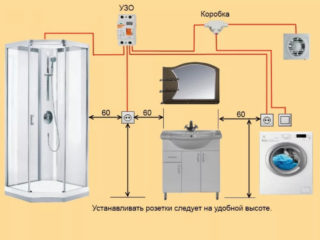
Installation of luminaires takes place in several stages. The first important step is planning and design. The quality of lighting depends on it. At the starting stage, the required lighting power is calculated.
Bathrooms and toilets require 200 lumens per square. This requirement is met:
- incandescent lamps 25 W - 200 lm, 100 W - 1350 lm;
- halogen bulbs - 42 W - 625 lm, 70 W - 1170 lm;
- fluorescent lamps - 40 W - 2000 lm;
- LED - 40 W - 6000 lm.
To calculate the power correctly, you need to take into account: the size of the room, the color characteristics and the level of reflection, the height and furnishings.
The next step is to select the section and type of wires. A correctly made cross-sectional diagram is considered the key to high-quality and safe electrical wiring. Here it is important to think over the places for the installation of future electrical appliances, sockets and the switches themselves. You should be guided by common tips:
- the approximate number of outlets is no more than three pieces;
- for washing machines, take a separate outlet;
- install the switch outside the bathroom, for example, in the corridor;
- the wiring lines run vertically and horizontally.
The final stage is installation work. Depending on the place of installation, the necessary equipment and the order of the work process change.
How to properly mount lamps
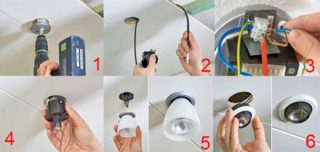
There are two main points on which the installation feature depends: the type of lighting device and the installation location.
- To the main ceiling. To conduct central lighting, spherical shades and lamp plates are used. If the ceiling surface is made of concrete, hardware or dowels are used for installation, and self-tapping screws are used from wood.
- Plasterboard false ceiling. In most cases, spotlights are installed here. Wiring is preliminarily planned. The installation process itself consists of a number of steps: mandatory disconnection of the voltage, connecting the luminaire to the cable terminals, introducing the luminaire into the housing and screwing in the light bulb.
The last option is a stretch ceiling. It is a very difficult installation process here, since the stretched canvas is very easily damaged. To avoid unpleasant moments, you should remember:
- careful design of luminaire markings prior to installation;
- compulsory cable insulation;
- formation of embedded platforms or hooks for all luminaires.
For stretch ceilings, it is recommended to use fluorescent or LED lamps.The devices do not heat up and do not cause damage to the web.
Safety regulations
- entrust the development of lighting schemes to professionals;
- use only moisture-resistant lamps;
- protect the metal parts of devices from rust and corrosion;
- sconce models should not be placed directly above the bathroom;
- the use of halogen and incandescent lamps in the first three functional areas is not allowed;
- no exposed wiring, extension cords or tees.
Lighting in the bathroom should be approached comprehensively, taking into account all the factors influencing the choice of lighting - from safety standards to a harmonious combination with interior solutions. Thanks to the right light, you can make the room comfortable and cozy.

